VPNs for Virtual Reality Tours: Ensuring Participant Privacy

Table of Contents
The Imperative of Privacy in Virtual Reality Tours
The immersive realm of virtual reality (VR) has ushered in a new era of interactive experiences, particularly through the advent of VR tours. These digital excursions transport users to various locations – real or imagined – offering unprecedented opportunities for exploration and engagement. From virtual walkthroughs of architectural marvels and historical sites to simulated training environments for professionals, VR tours are rapidly transforming industries like tourism, education, and healthcare.
However, like any technology that gathers and processes user data, VR tours raise significant concerns about privacy. When participants immerse themselves in these virtual environments, their actions, movements, and even physiological responses can be recorded and analyzed, creating a detailed profile of their behavior and preferences. This collected data, if not properly secured, could be vulnerable to breaches, misuse, or even exploitation.
Therefore, ensuring "participant privacy" is paramount to fostering trust and encouraging widespread adoption of VR tours. One effective solution for mitigating these privacy risks is the strategic implementation of Virtual Private Networks (VPNs). A VR tour VPN creates a secure, encrypted tunnel for data transmission between the participant's device and the VR tour server.
This encryption makes it significantly more difficult for unauthorized parties to intercept and decipher sensitive information. Furthermore, a VPN masks the participant's IP address, effectively hiding their true location and preventing geographical tracking. This added layer of anonymity is crucial for protecting participants from targeted advertising, surveillance, and other potential privacy violations.
Beyond basic encryption and IP masking, a VR tour VPN can offer a range of additional features to enhance privacy. Some VPNs provide specialized servers optimized for streaming VR content, ensuring a smooth and lag-free experience. Others offer advanced security protocols and features like kill switches, which automatically disconnect the internet connection if the VPN connection drops, preventing data from being exposed.
The effectiveness of a VR tour VPN hinges on several key factors. First and foremost, the VPN provider must have a strong commitment to user privacy and a transparent privacy policy. They should not log user activity or sell data to third parties.
Secondly, the VPN should utilize robust encryption protocols, such as AES-256, to ensure the highest level of data security. Thirdly, the VPN should have a wide network of servers located around the globe, allowing participants to connect to a server that is geographically close to the VR tour server, minimizing latency and improving performance. Finally, the VPN should be easy to use and compatible with a variety of VR devices and platforms.
Implementing a VR tour VPN is not merely a technical consideration; it's an ethical imperative. Organizations that offer VR tours have a responsibility to protect the privacy of their participants and to be transparent about their data collection practices. By prioritizing privacy and security, organizations can build trust with their users and create a VR ecosystem that is both innovative and respectful of individual rights.
In the following sections, we will delve deeper into the specific privacy challenges associated with VR tours, the benefits of using a VR tour VPN, and the best practices for selecting and implementing a VPN solution. As VR technology continues to evolve, the importance of protecting participant privacy will only grow, making VR tour VPNs an essential tool for responsible VR development and deployment.
The concept of "participant privacy" within the context of VR tours encompasses a multifaceted range of considerations. It extends beyond simply protecting personally identifiable information (PII), such as names and email addresses. It also includes safeguarding sensitive behavioral data, such as gaze tracking information, interaction patterns, and even biometric data gathered through VR headsets.
The more immersive and interactive the VR experience, the greater the potential for data collection and the higher the stakes for privacy breaches. For example, a VR tour of a virtual museum might track which exhibits a participant spends the most time viewing, providing valuable insights into their interests and preferences. While this data could be used to enhance the VR experience in the future by tailoring content to individual interests or providing personalized recommendations, it could also be exploited for targeted advertising or other potentially harmful purposes if it falls into the wrong hands or is accessed by malicious actors.
Imagine a scenario where the VR tour is sponsored by various brands; the data collected could be used to create highly targeted advertisements based on the participant's implicit preferences revealed through their interactions within the virtual environment. Similarly, VR training simulations, such as medical procedures or emergency response scenarios, could collect data on a participant's physiological responses, such as heart rate and stress levels. This data could be used legitimately to assess performance and identify areas for improvement, providing valuable feedback for training and development.
However, it could also be used to create detailed psychological profiles, potentially leading to discriminatory practices in employment or insurance. The challenges of "data protection" in VR tours are compounded by the fact that VR technology is still relatively new and evolving, and legal and ethical frameworks are still catching up. Many existing data protection laws, such as GDPR and CCPA, may not be fully equipped to address the unique privacy challenges posed by VR.
For example, it may be difficult to obtain informed consent from VR participants, particularly if they are not fully aware of the types of data being collected and how it will be used, or if the consent process is buried within lengthy and complex terms of service that are rarely read in full. Furthermore, the immersive nature of VR can make it difficult for participants to exercise their rights to access, correct, or delete their data. Navigating virtual menus to manage privacy settings can be cumbersome and detract from the overall experience.
To address these challenges effectively, organizations offering VR tours must adopt a proactive and comprehensive approach to data protection. This should include implementing robust security measures to prevent data breaches, such as encryption at rest and in transit, regular security audits, and penetration testing. It also involves developing clear and transparent privacy policies that are easily understandable to the average user and that explicitly state what data is being collected, how it is being used, and with whom it is being shared.
Organizations should also obtain informed consent from participants before collecting any data, ensuring that they understand their rights and options. Furthermore, organizations should also consider adopting privacy-enhancing technologies, such as differential privacy and federated learning, to minimize the risk of re-identification of sensitive data. Differential privacy adds random noise to the data before it is analyzed, making it difficult to identify individual users.
Federated learning allows models to be trained on decentralized data without sharing the raw data, preserving privacy. In addition to technical and policy measures, organizations should also focus on educating participants about their privacy rights and empowering them to make informed decisions about their data. This could involve providing clear and concise information about the types of data being collected, the purposes for which it will be used, and the measures being taken to protect their privacy.
User-friendly tutorials and interactive guides can help participants understand and manage their privacy settings effectively. Ultimately, ensuring participant privacy in VR tours requires a collaborative effort involving technology developers, policymakers, and users. By working together, we can create a VR ecosystem that is both innovative and respectful of individual privacy.
The consideration of the nature of data collected, in tandem with the protection of this data, is of vital importance for building trust and fostering the responsible growth of VR technology.
"VR content security" is a critical aspect of safeguarding VR tours, encompassing both the prevention of unauthorized access to the content itself and the protection of intellectual property rights. In secure VR environments, the content itself is valuable and is frequently the subject of content piracy, modification, or even malicious alteration. The creation of high-quality VR tours often involves significant investment in terms of time, resources, and expertise, including skilled 3D artists, developers, and designers.
Protecting this investment from unauthorized copying, distribution, or modification is essential for ensuring the long-term viability of the VR tour industry and fostering continued innovation. Imagine a scenario where a meticulously crafted VR tour of a historical landmark is illegally copied and distributed online, undermining the original creators' ability to monetize their work and potentially damaging their reputation if the copy is of inferior quality. Or consider a VR training simulation that is maliciously altered to introduce errors or inaccuracies, leading to potentially dangerous consequences for trainees who rely on it.
One of the most effective ways to protect VR content is to implement robust digital rights management (DRM) technologies. DRM systems can control access to VR content, restrict copying and distribution, and track usage patterns. For instance, DRM can be used to ensure that only authorized users with valid licenses can access a VR tour, or to prevent users from recording or streaming the content without permission.
However, DRM systems can also be complex and expensive to implement, and they can sometimes interfere with the user experience, leading to frustration and dissatisfaction. Overly restrictive DRM measures can make it difficult for legitimate users to access and enjoy VR content, potentially driving them to seek out unauthorized copies. Organizations must carefully weigh the benefits and drawbacks of DRM before implementing it, striking a balance between content protection and user experience.
In addition to DRM, organizations can employ various other security measures to protect "VR content security". Watermarking, for example, can be used to embed invisible or subtle marks within the VR content, making it possible to identify the source of any unauthorized copies. Encryption can be used to protect the VR content from being accessed or modified without authorization.
Access control lists (ACLs) can be used to restrict access to VR content based on user roles and permissions. Regular security audits and penetration testing can help identify and address vulnerabilities in the VR content and the systems that support it. Furthermore, organizations should actively monitor online channels for unauthorized copies of their VR content and take appropriate action to remove them.
This might involve sending takedown notices to websites and hosting providers that are distributing infringing content, or pursuing legal action against individuals or organizations that are engaged in copyright infringement. Beyond these technical measures, education and awareness are also crucial for protecting VR content. Users should be educated about the importance of respecting intellectual property rights and the consequences of engaging in piracy.
Developers and designers should be trained in secure coding practices and best practices for protecting VR content from unauthorized access and modification. By combining robust technical measures, proactive monitoring, and ongoing education, organizations can effectively protect their VR content and ensure the continued growth and success of the VR tour industry. This ultimately supports the creation of high-quality, innovative VR experiences that benefit both creators and users.
The security measures taken must take into account the impact on performance and user experience.
The synergy between a "VR tour VPN" and the overall security posture of a VR tour platform is undeniable. A VPN is not a silver bullet, but rather a crucial component within a layered security approach aimed at bolstering both "participant privacy" and "VR content security." It acts as a gatekeeper, establishing a secure and encrypted connection that safeguards data during transit, a particularly vulnerable stage where interception is a significant threat. When a participant initiates a VR tour, their device establishes a connection with the VR tour server.
Without a VPN, this connection is often unencrypted, leaving the data transmitted – including sensitive information about the participant and the VR content itself – susceptible to eavesdropping by malicious actors. A "VR tour VPN" effectively neutralizes this threat by creating an encrypted tunnel that shields the data from prying eyes. This encryption ensures that even if the data is intercepted, it will be unreadable and unusable to unauthorized parties.
Beyond encryption, a "VPN for VR" provides an additional layer of anonymity by masking the participant's IP address. This makes it more difficult to track the participant's location and online activities, further enhancing their privacy. This is especially important in VR environments, where participants may be sharing sensitive personal information or engaging in activities that they would prefer to keep private.
Moreover, a "VR tour VPN" can help circumvent geo-restrictions, allowing participants to access VR tours that may be unavailable in their region due to licensing agreements or other limitations. This expands access to VR content and promotes a more inclusive and equitable VR experience. However, it's important to note that not all VPNs are created equal.
The effectiveness of a "VR tour VPN" depends on several factors, including the strength of the encryption protocols used, the speed and reliability of the VPN connection, the VPN provider's privacy policy, and the location of the VPN servers. Organizations offering VR tours should carefully vet VPN providers to ensure that they meet the highest standards of security and privacy. Look for VPNs that use strong encryption protocols such as AES-256, have a no-logs policy, and offer a wide range of server locations.
Furthermore, consider the VPN's performance, as a slow or unreliable VPN connection can significantly detract from the VR experience. A high-quality "VPN for VR" should provide a seamless and lag-free connection that doesn't compromise the immersive nature of the VR tour. The integration of a "VR tour VPN" into the VR tour platform should be seamless and transparent to the participant.
The VPN connection should be established automatically when the VR tour is launched, and the participant should not be required to manually configure or manage the VPN settings. This ensures that all participants are protected by the VPN, regardless of their technical expertise. In addition to the technical aspects of implementing a "VR tour VPN," it's also important to educate participants about the benefits of using a VPN and how it protects their privacy.
This can help build trust and encourage wider adoption of VPN technology. By providing clear and concise information about the VPN and its role in safeguarding their data, organizations can empower participants to make informed decisions about their privacy. Ultimately, the integration of a "VR tour VPN" is a crucial step in creating a secure and trustworthy VR tour platform.
It demonstrates a commitment to "data protection" and "participant privacy", fostering user confidence and encouraging widespread adoption of VR technology. The implementation of such a system should improve user confidence.
Selecting the right "VPN for VR" involves a careful evaluation of various factors to ensure optimal "data protection," robust "VR content security," and a seamless user experience. Given the sensitive nature of data potentially collected during VR tours, from behavioral patterns to potentially biometric information depending on the hardware used, the chosen VPN must act as a staunch guardian of "participant privacy." A paramount consideration is the VPN provider's logging policy. A strict "no-logs" policy is non-negotiable.
This means the provider should not retain any records of users' browsing activity, connection timestamps, IP addresses, or any other data that could be used to identify or track them. Scrutinize the provider's privacy policy carefully, looking for clear and unambiguous language that guarantees data anonymity. Independent audits of the provider's logging practices can offer further reassurance.
Encryption strength is another critical factor. The gold standard is AES-256 encryption, a military-grade encryption protocol that is virtually impenetrable. Ensure the "VPN for VR" utilizes this protocol to safeguard data transmitted between the participant's device and the VR tour server.
Support for multiple VPN protocols is also desirable, as it provides flexibility and allows users to choose the protocol that best suits their needs and security preferences. OpenVPN is generally considered the most secure and reliable protocol, but IKEv2/IPsec and WireGuard are also viable options. The server network of the "VPN for VR" plays a crucial role in both performance and accessibility.
A wide network of servers, strategically located around the globe, allows participants to connect to a server that is geographically close to the VR tour server, minimizing latency and improving performance. This is particularly important for VR tours, which require a stable and high-bandwidth connection to deliver a seamless and immersive experience. A larger server network also increases the likelihood of finding a server that is not congested, further enhancing performance.
The VPN's speed and reliability are paramount. A slow or unreliable VPN connection can significantly detract from the VR experience, causing lag, stuttering, and disconnections. Look for VPNs that are known for their speed and stability, and that offer unlimited bandwidth.
Test the VPN's performance on different server locations to ensure it meets your needs. The user interface and ease of use are also important considerations, especially if you are offering VR tours to a wide audience with varying levels of technical expertise. The VPN client should be intuitive and easy to navigate, with clear instructions and helpful guidance.
It should also be compatible with a variety of VR devices and platforms, ensuring that all participants can easily connect to the VPN. Additional security features can further enhance the protection offered by the "VPN for VR". A kill switch automatically disconnects the internet connection if the VPN connection drops, preventing data from being exposed.
DNS leak protection prevents DNS requests from being sent outside the VPN tunnel, further protecting privacy. Double VPN or multi-hop connections route traffic through multiple servers, adding an extra layer of encryption and anonymity; though this can sometimes impact speeds. Finally, consider the VPN provider's reputation and customer support.
Read reviews from independent sources to get a sense of the provider's reliability and trustworthiness. Look for providers that offer responsive and helpful customer support, in case you encounter any issues. By carefully considering these factors, organizations can select the right "VPN for VR" to ensure optimal "data protection," robust "VR content security," and a seamless user experience for all participants.
Ultimately, the choice should reflect a commitment to safeguarding "participant privacy" and fostering trust in the immersive world of VR tours.
Stay Updated
Get the latest VPN news, tips, and exclusive deals to your inbox.




